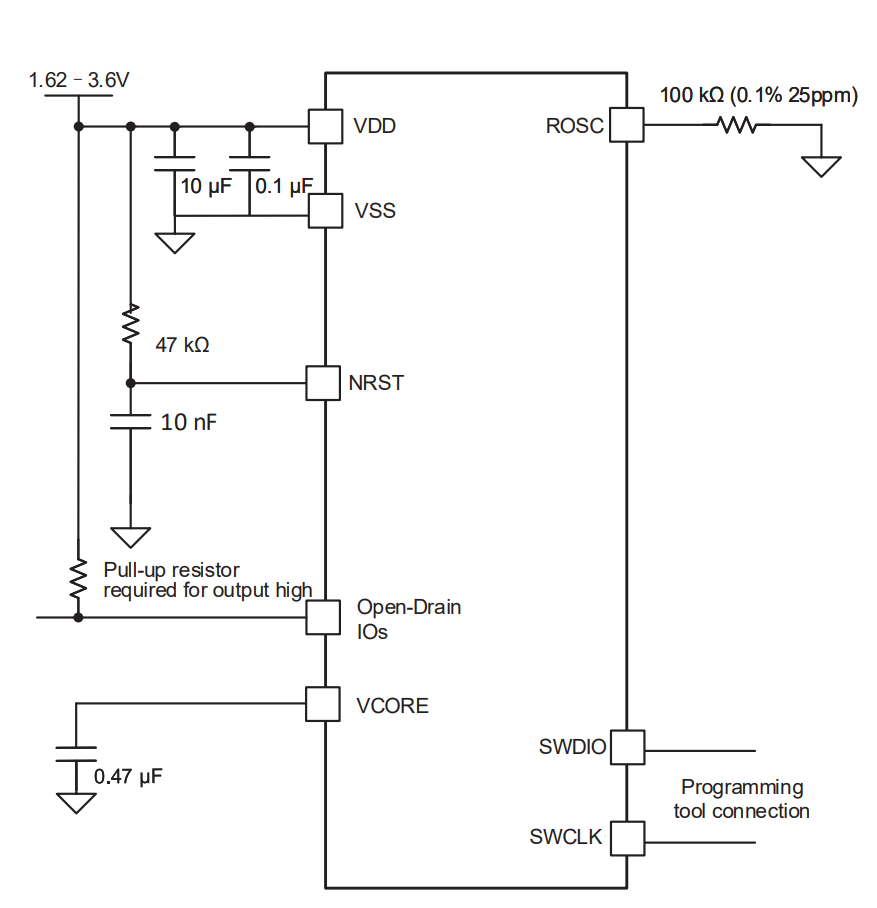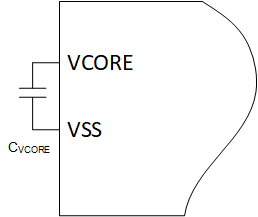-
MSPM0 L-Series MCUs Hardware Development Guide SLAAE75A November 2022 – March 2023 MSPM0L1105 , MSPM0L1106 , MSPM0L1227 , MSPM0L1227-Q1 , MSPM0L1228 , MSPM0L1228-Q1 , MSPM0L1303 , MSPM0L1304 , MSPM0L1304-Q1 , MSPM0L1305 , MSPM0L1305-Q1 , MSPM0L1306 , MSPM0L1306-Q1 , MSPM0L1343 , MSPM0L1344 , MSPM0L1345 , MSPM0L1346 , MSPM0L2227 , MSPM0L2227-Q1 , MSPM0L2228 , MSPM0L2228-Q1
-
MSPM0 L-Series MCUs Hardware Development Guide
MSPM0 L-Series MCUs Hardware Development Guide
Abstract
The MSPM0 L-series microcontroller (MCU) portfolio offers a wide variety of 32-bit MCUs with ultra-low-power and integrated analog and digital peripherals for sensing, measurement and control applications. This application note covers information needed for hardware development with MSPM0 L-series MCUs, including detailed hardware design information for power supplies, reset circuitry, clocks, debugger connections, key analog peripherals, communication interfaces, GPIOs, and board layout guidance.
Trademarks
LaunchPad™ and EnergyTrace™ are trademarks of Texas Instruments.
All trademarks are the property of their respective owners.
1 MSPM0L Hardware Design Check List
#GUID-0388845E-77CD-4FEF-AB17-597547F7F425/GUID-9D414E7A-A6E4-4DCE-A5B5-9492C6B1C56D describes the main signal that needs to be checked during the MSPM0L hardware design process. The following sections give more details.
| Pin (1) | Description | Requirements |
|---|---|---|
| VDD | Power supply positive pin | Place 10-µF and 100-nF capacitors between VDD and VSS, and keep those part close to VDD and VSS. |
| VSS | Power supply negative pin | |
| VCORE | Core voltage (typical: 1.35 V) | Connect a 470-nF capacitor to VSS, do not supply any voltage or apply any external load to the VCORE pin. |
| NRST | Reset pin | Connect an external 47-kΩ pullup resistor with a 10-nF pulldown capacitor. |
| ROSC | External reference resistor pin |
|
| VREF+ | Voltage reference power supply for external reference input |
|
| VREF- | Voltage reference ground supply for external reference input | |
| SWCLK | Serial wire clock from debug probe | Internal pullup to VDD, does not need any external part. |
| SWDIO | Bidirectional (shared) serial wire data | Internal pulldown to VSS, does not need any external part. |
| PA0, PA1 | Open-drain I/O | Pull-up resistor required for output high |
| PA18 | Default BSL invoke pin | Keep pulled down to avoid entering BSL mode after reset. The BSL invoke pin can be remapped. |
| PAx (exclude PA0, PA1) | General-purpose I/O | Set corresponding pin functions to GPIO (PINCMx.PF = 0x1) and configure unused pins to output low or input with internal pullup or pulldown resistor. |
| OPAx_IN0-(2) | OPAx inverting terminal input 0 | This pin is high-impedance, does not need any external part if unused. |
TI recommends connecting a combination of a 10-μF and a 0.1-nF low-ESR ceramic decoupling capacitor to the VDD and VSS pins . Higher-value capacitors can be used but can impact supply rail ramp-up time. Decoupling capacitors must be placed as close as possible to the pins that they decouple (within a few millimeters).
The NRST reset pin is required to connect an external 47-kΩ pullup resistor with a 10-nF pulldown capacitor.
The SYSOSC frequency correction loop (FCL) circuit utilizes an external 100-kΩ resistor, populated between the ROSC pin and VSS, to stabilize the SYSOSC frequency by providing a precision reference current for the SYSOSC. This resistor is not required if the SYSOSC FCL is not enabled.
A 0.47-µF tank capacitor is required for the VCORE pin and must be placed close to the device with minimum distance to the device ground.
For 5-V-tolerant open drain (ODIO), a pullup resistor is required to output high, this is required for I2C and UART functions if the ODIO are used.
 Figure 1-1 MSPM0L Typical Application Schematic
Figure 1-1 MSPM0L Typical Application Schematic2 Power Supplies in MSPM0L Devices
Power is supplied to the device through the VDD and VSS connections. The device supports operation with a supply voltage of 1.62 V to 3.6 V and can start with a 1.62-V supply. The power management unit (PMU) generates the regulated core supplies for the device and provides supervision of the external supply. It also contains a bandgap voltage reference used by the PMU and other analog peripherals. VDD is used directly to provide the IO supply (VDDIO) and the analog supply (VDDA). VDDIO and VDDA are internally connected to VDD so that additional power supply pins are not required (see the device-specific data sheet for details).
2.1 Digital Power Supply
VCORE Regulator
There is an internal low-dropout linear voltage regulator to generate a 1.35-V supply rail to power the device core. In general, the core regulator output (VCORE) supplies power to the core logic, which includes the CPU, digital peripherals and the device memory. The core regulator requires an external capacitor (CVCORE) which is connected between the device VCORE pin and VSS (ground) (see #GUID-13FB8421-B5DF-4D50-92BB-3A11E8DFDE90). See the device-specific data sheet for the correct value and tolerance of CVCORE. CVCORE should be placed close to the VCORE pin.
The core regulator is active in all power modes except for SHUTDOWN. In all other power modes (RUN, SLEEP, STOP, and STANDBY) the drive strength of the regulator is configured automatically to support the max load current of each mode. This reduces the quiescent current of the regulator when using low power modes, improving low power performance.
 Figure 2-1 VCORE Regulator Circuit
Figure 2-1 VCORE Regulator Circuit